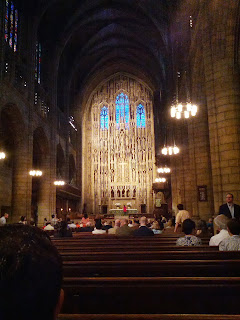We walked to meet Michael where he works today. I took pictures of the wonderful history of Chelsea. The architecture is just wonderful. Here's a snippet of Chelsea (from wikipedia):
Chelsea is a neighborhood on the West Side of the borough of Manhattan in New York City. The district's boundaries are roughly 14th Street to the south, 30th Street to the north, the western boundary of the Ladies' Mile Historic District – which lies between the Avenue of the Americas (Sixth Avenue) and Seventh Avenue – to the east, and the Hudson River and West Street to the west.
Chelsea takes its name from the estate and Georgian-style
house of retired British Major Thomas Clarke, who obtained the property
when he bought the farm of Jacob Somerindyck on August 16, 1750. The
land was bounded by what would become 21st and 24th Streets, from the
Hudson River to Eighth Avenue.[5] Clarke chose the name "Chelsea" after the manor of Chelsea, London, home to Sir Thomas More.
The picture below is from
Wikipedia. I've posted excerpts throughout this post from Wikipedia, and the link to the article is at the bottom of this page.
Wikipedia:
 |
| The Cushman Row, 406-418 W. 20th St., dates from 1840 | |
These are the pictures that I took today:
 |
| antique setting, crowded sidewalks |
In the early 1940s, tons of uranium for the Manhattan Project
were stored in the Baker & Williams Warehouse at 513-519 West 20th
St. The uranium was removed and decontaminated only in the late 1980s or
early 1990s.
 |
| This picture doesn't do the detail work justice. The tips on the left side are white |
The industrialization of western Chelsea brought immigrant populations from many countries to work in the factories,[8] including a large number of Irish
immigrants, who dominated work on the Hudson River piers that lined the
nearby waterfront and the truck terminals integrated with the freight
railroad spur.[9]
As well as the piers, warehouses and factories, the industrial area
west of Tenth Avenue also included lumberyards and breweries, and
tenements built to house the workers.
 |
| row houses |
The new neighborhood thrived for three decades, with many single family
homes and rowhouses, in the process expanding past the original
boundaries of Clarke's estate, but an industrial zone also began to
develop along the Hudson.[5] In 1847 the Hudson River Railroad laid its freight tracks up a right-of-way between Tenth and Eleventh Avenues, separating Chelsea from the Hudson River waterfront. By the time of the Civil War, the area west of Ninth Avenue and below 20th Street was the location of numerous distilleries making turpentine and camphene, a lamp fuel. In addition, the huge Manhattan Gas Works complex, which converted bituminous coal into gas, was located at Ninth and 18th Street.[7]
 |
| love the detail work |
 |
| London Terrace was one of the world's largest apartment blocks when it opened in 1930, with a swimming pool, solarium, gymnasium, and doormen dressed as London bobbies. The complex takes up the full block between Ninth and Tenth Avenues and 23rd and 24th Streets. |
 |
| love the different colors in the row houses |
 |
| Other side of the 1920's long building, antique setting on pic |
 |
| Interesting: look at the building along the left, and right margin... |
 |
| close shot of the previous pic on the left...antique setting on pic |
 |
| detail pic of bldg on right side of pic (2 up) |
If you care to read more about the history of Chelsea, here's the link:
http://en.wikipedia.org/wiki/Chelsea,_Manhattan






















































